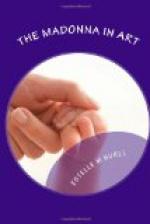The Belle Jardiniere gazes into her boy’s face in fond absorption. The Tempi Madonna holds him to her heart, pressing her lips to his soft cheek. In the Orleans and Colonna pictures she smiles indulgently into his eyes as he lies across her lap, plucking at the bosom of her dress. Other pictures show the two eagerly reading together from the Book of Wisdom (The Conestabile and Ansidei Madonnas).
The painter’s later work evinces a growing maturity of thought. In the Holy Family of Francis I., how strong and tender is the mother’s attitude, as she stoops to lift her child from his cradle; in the Chair Madonna, how protecting is the capacious embrace with which she gathers him to herself in brooding love. No technical artistic education is necessary for the appreciation of such pictures. All who have known a mother’s love look and understand, and look again and are satisfied.
Correggio touches the heart in much the same way; he, too, saw the world through rose-colored glasses. His interpretation of life is full of buoyant enjoyment. Beside the tranquil joy of Raphael’s ideals, his figures express a tumultuous gladness, an overflowing gayety. This is the more curious because of the singular melancholy which is attributed to him. The outer circumstances of his life moved in a quiet groove which was almost humdrum. He passed his days in comparative obscurity at Parma, far from the great art influences of his time. But isolation seemed the better to develop his rare individuality. He was the architect of his own fortunes, and wrought out independently a style peculiar to himself. His most famous Madonna pictures are large compositions, crowded with figures of extravagant attitudes and expression. The fame of these more pretentious works rests not so much upon their inner significance as upon their splendid technique. They are unsurpassed for masterly handling of color, and for triumphs of chiaroscuro.
There are better qualities of sentiment in the smaller pictures, where the mother is alone with her child. It is here that we find something worthy to compare with Raphael. There are several of these, produced in rapid succession during the period when the artist was engaged upon the frescoes of S. Giovanni (Parma), and soon after marriage had opened his heart to sweet, domestic influences.
The first was the Uffizi picture, so widely known and loved. The mother has gathered up her mantle so that it covers her head and drops at one side on a step, forming a soft, blue cushion for the babe. Here the little darling lies, looking up into his mother’s face. Kneeling on the step below, she bends over him, with her hands playfully outstretched, in a transport of maternal affection.
Following this came the picture now in the National Gallery, called the Madonna della Cesta, from the basket that lies on the ground. It is a domestic scene in the outer air: the mother is dressing her babe, and smilingly arrests his hand, which, on a sudden impulse, he has stretched towards some coveted object. The same face is almost exactly repeated in the Madonna of the Hermitage Gallery (St. Petersburg), who offers her breast to her boy, at that moment turning about to receive some fruit presented by a child angel. There are two duplicates of this picture in other galleries.




